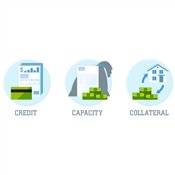95 LTV: Are Low Down Payment Mortgage Loans Available?
Does purchasing a home make you think you need a 20% down payment? Depending on the price of the home, 20% can be a lot of money. Luckily, there are loans that allow less than 20% down. Deciding whether you should wait until you have 20% saved or not can seem complicated. We discuss your options here.
 |
What Is a Down Payment?
First, let's discuss the down payment. It is cash paid at the closing. This cash reduces the amount you must borrow. For example, let's say you agree to buy a home for $200,000. Your lender preapproved you for a loan amount of $190,000. You must supply the remaining $10,000 in cash. This is your down payment. Every loan program requires a specific down payment. The most common loan programs are:
- FHA: minimum 3.5% down
- Conventional 97: minimum 3% down
- Standard Conventional: minimum 5% down
For more information on each loan type, see our article The Different Types of Mortgages.
Why the Down Payment Matters
The down payment affects your chances of approval. The more money you put down, the less the lender must provide. In the eyes of the lender, this means a lower risk. The amount you borrow compared to the value of the home is the loan-to-value ratio, or LTV. The LTV affects your eligibility for specific loan programs. It also affects your interest rate and fees. The higher the LTV, the higher risk the lender takes. Higher risk often means more costs and higher interest rates.
Usually having a large down payment shows a lender financial responsibility. Don't worry if you don't have 20% to put down on a home, though. There are other ways to show financial responsibility including:
- Credit scores higher than 700
- Low use of available credit
- Timely payments on all bills
Lenders piece together different aspects of your financial life. They use this puzzle to determine your loan program, fees, and interest rate. A higher down payment gives you more investment in the home. This usually means a lower likelihood of default. However, it does not always make sense to use up your entire savings to make a large down payment. We discuss this in more detail below.
The 20% Rule
The golden rule in the mortgage industry is to put down 20% on a home. On the $200,000 loan from above, this means $40,000. Many first-time homebuyers don't have this much saved. This does not leave you without a loan program, though. A 20% down payment may open a few more doors. But, if it means putting your entire life savings down, it might not be the right choice.
Why You Might Consider a Low Down Payment Option
When you make a down payment, you pay cash towards your home. You will not see this money again until you refinance or sell your home. This could mean many years down the road. In return, you gain something called home equity. Home equity is not a liquid asset. If you need the money, it could take months to access it. You must either sell your home or refinance your loan to access it.
Home equity is the amount of the home's value that you own. If you put $40,000 down on a home you buy for $200,000, you have 20% home equity. If this cleared out your savings account, you have no liquid assets. What happens if you have an emergency? You don't have any savings to use. A smaller down payment gives you more liquidity in the future.
Options for Low Down Payment Borrowers
Today, mainstream borrowers have several options for low down payment loans. It used to be that only very low income families or first-time homebuyers qualified. Today, though, many people qualify for any of the programs we discussed above. Here we talk about the programs' specifics.
96.5 LTV: FHA Loans
FHA loans are no longer limited to first-time homebuyers. This program only requires 3.5% down. On a $150,000 loan, this means $5,250. Compare this to the standard 20% down payment of $30,000. There is a $24,750 difference - that is no small change!
FHA loans have flexible underwriting guidelines. It is a good choice if you have past credit issues. It also works well for borrowers with high debt-to-income ratios. This means your monthly debt obligations take up a large chunk of your gross monthly income. Conventional loans don't allow your mortgage payment to take up more than 28% of your income. FHA loans allow up to 31% of your income for your mortgage payment.
FHA loans are also more forgiving on the back-end. Conventional loans maximize your total monthly debts, including your mortgage at 36% of your monthly income. FHA loans, on the other hand, allow a 43% back-end ratio.
97 LTV: Conventional 97
Fannie Mae offers a conventional version of low down payment programs. You need 3% down for this program. On the $150,000 loan, this equals $4,500 - a $750 savings over the FHA loan.
To qualify for this loan, you must not have owned a home in the last 3 years. This is the new definition of a "first-time homebuyer." This helps borrowers who lost their home during the housing crisis. After three years, they can have a "fresh start." A few other requirements include:
- Good credit scores (higher than 680)
- Low debt ratios
- Stable employment
Borrowers often prefer conventional financing to FHA loans because it's more affordable. In order to qualify, you must live in the property and it must be a single unit. You cannot use it to buy a 2-, 3-, or 4-unit property. However, it can be a single-family home, PUD (planned unit development), or condominium. The mortgage must also be a fixed rate - no adjustable rate mortgages are allowed.
95 LTV: Fannie Mae Conventional
If you have a little more money available for a down payment, consider a standard Fannie Mae loan. These loans require only 5% down. On the $150,000 loan, this means $7,500. That equates to $3,000 more than the Conventional 97 loan, but you don't have to be a first-time homebuyer to qualify.
There are a few differences between the Conventional 97 and standard Fannie Mae loan. Fannie Mae sells both on the secondary market. They both have similar qualifying requirements too. The largest difference, however, is the amount of mortgage insurance (a.k.a. PMI) you will pay. Lenders base PMI on your loan-to-value ratio and your credit score. With the lower LTV, you have a chance of paying less in insurance. You may also secure a lower interest rate because of the lower LTV required for a standard Fannie Mae loan.
Piggy Back Loans
Paying PMI is not ideal for anyone. Luckily, there is one more option - piggyback loans. This option is often called the 80/15/5 loan. The percentages refer to where the money originates. In this case, the first mortgage provides 80% of the cost and 15% comes from a home equity line of credit. The remaining 5% is your down payment.
The money from the HELOC pays your down payment. The loans close at the same time, but the funds from the HELOC go to the seller. The 5% that comes from you also goes to the seller. The remaining 80% is a conventional loan with favorable terms. Because you put 20% down on the home, you do not have to pay PMI. But you do have 2 mortgage payments to make each month.
FHA vs Conventional Low Down Payment Loans
The Conventional 97 and FHA loans are the two most common choices. With a difference of 0.5% in required down payment, how do you decide? You should base your decision on your qualifying factors.
Conventional loans with less than 20% down charge PMI. All FHA loans charge mortgage insurance. There is a difference, though. You can cancel PMI in the future. You cannot cancel FHA mortgage insurance.
FHA loans also charge upfront mortgage insurance. You pay this premium at the closing in cash. This adds to the cost of the loan and depletes the money you have set aside for emergencies. Conventional loans do not charge insurance upfront. Conventional loans also allow you to cancel your PMI once you owe less than 80% of the value of the home. You must request the cancellation in writing. If you don't request it, by law, the lender must cancel your PMI when you hit 78% LTV.
Because lenders base PMI on your credit score and LTV, you should use those factors to determine which loan is the right choice. If you have a credit score lower than 680 and have less than 5% to put down, the FHA loan might be the better choice. PMI on a loan with a low credit score is usually pretty high. Despite the fact that you pay mortgage insurance for the life of an FHA loan, you can always refinance into a conventional loan in the future.
The Bottom Line
Choosing the right loan depends on many factors. Understanding all of your options can help you decide. There is no right or wrong answer.
Consider your long-term plans and how much money you have in savings:
- If you see yourself staying in the home long-term, consider the cost of paying lifetime mortgage insurance on an FHA loan.
- If making a large down payment depletes your savings, consider your low down payment options.
- Look at the overall cost of each loan option available to you. Look at closing costs, interest rates, and the cost over the life of the loan.
Considering all aspects of the loan will help you decide whether spending your entire savings on the down payment is the right choice for you.
Write to Kim P at feedback@creditdonkey.com. Follow us on Twitter and Facebook for our latest posts.
Read Next:






